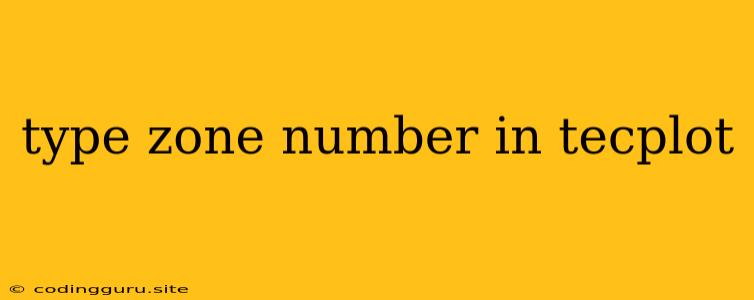How to Define Zone Numbers in Tecplot
Tecplot is a powerful tool for visualizing and analyzing data, especially when working with large datasets containing multiple zones. Understanding how to define zone numbers is crucial for effectively organizing and managing your data within the software. This article will guide you through the process of assigning zone numbers in Tecplot, ensuring you can work with your data efficiently.
What are Zone Numbers?
In Tecplot, a zone represents a distinct region of data within your dataset. Imagine your data as a collection of different 3D objects, each with its own properties and coordinates. Each of these objects is a zone in Tecplot. Zone numbers are unique identifiers that help Tecplot differentiate these regions. This allows for more organized analysis and plotting, especially when dealing with complex datasets containing numerous regions.
Why Do Zone Numbers Matter?
Here are some reasons why understanding zone numbers is essential in Tecplot:
- Data Organization: Zone numbers help you categorize and manage your data effectively. Instead of having a single massive dataset, you can treat each zone as a distinct entity.
- Visualization Control: Tecplot offers features that allow you to manipulate and plot data based on zone numbers. You can choose to display specific zones, hide others, or even apply different color palettes to each zone for better visualization.
- Analysis Flexibility: Zone numbers provide a way to perform calculations or analyses specifically on a particular region of your data, making your analysis more focused and efficient.
How to Define Zone Numbers in Tecplot
There are two primary ways to define zone numbers in Tecplot:
- During Data Import:
- When importing your data into Tecplot, you might have the option to assign zone numbers directly within the import dialog. This is usually facilitated by a column in your data file containing the zone numbers.
- Using the Tecplot Interface:
- If your data doesn't already contain zone numbers, you can define them within Tecplot itself.
- Navigate to the "Data" menu and select "Zone Manager."
- In the Zone Manager window, you can rename existing zones or create new ones.
- Each zone will have a unique zone number associated with it.
Example: Assigning Zone Numbers to a Dataset
Let's say you have a dataset representing a car model, with separate zones for the chassis, engine, and wheels. When importing this dataset into Tecplot, you might assign the following zone numbers:
- Zone 1: Chassis
- Zone 2: Engine
- Zone 3: Front Wheels
- Zone 4: Rear Wheels
This allows you to easily differentiate between these components during visualization and analysis.
Tips for Defining Zone Numbers
- Use a Logical Structure: Consider using a clear numbering system that reflects the organization of your data. For example, you can use consecutive numbers for zones within a single component.
- Utilize Zone Names: Always provide meaningful names to your zones to easily identify their purpose and function within your dataset.
- Exploit Zone Manager: Use the Zone Manager within Tecplot to efficiently modify existing zones and create new ones as needed.
Conclusion
Defining zone numbers in Tecplot is an essential skill for handling complex datasets with multiple regions. By understanding how to define zone numbers, you can effectively organize, analyze, and visualize your data, unlocking the full potential of Tecplot for your research, design, and analysis projects.
